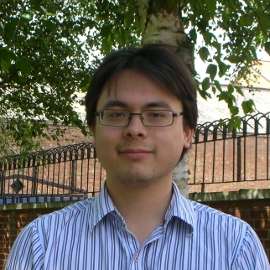It's been a bumper week of contemporary music at the Barbican, with Nico Muhly and the Britten Sinfonia, Bang on a Can, and Krzysztof Penderecki and Jonny Greenwood all taking the stage. The diversity of talents and styles on display can only be encouraging, and last night's offering was a fitting climax to a fascinating week.
The Penderecki/Greenwood concert, performed by a strings-only AUKSO Chamber Orchestra with both Marek Mos and Penderecki himself conducting, was in the odd position of being at once the most avant-garde of the week's three offerings, and also the most populist. Avant-garde because of the works peformed – especially Penderecki's iconic, bold early 1960s works Threnody for the Victims of Hiroshima and Polymorphia – and populist, inevitably, because Greenwood is the lead guitarist from Radiohead and would sell out any venue at the drop of a hat. But anyhow, it was thrilling to see a packed house in the Barbican Hall, and delightful to be a part of the evening's hushed, reverential atmosphere. Everyone seemed fascinated by the concert, and the intensity of attention which was focused on the performers would put many a more 'traditional' concert audience to shame.
The programme alternated works by the two composers, Greenwood's Popcorn Superhet Receiver following Penderecki's Threnody, and Greenwood's 48 Responses to Polymorphia very logically positioned after Polymorphia itself. Jonny Greenwood has often spoken of his deep interest in Penderecki's music, and the setup this evening had a sort of master-and-pupil air to it. Victory for the master was inevitable, but the exchange was productive.
Penderecki's Threnody was originally composed as an abstract work entitled 8'37'', and only gained its dedication after the composer heard it performed live. It is an incredibly, unaccountably moving work requiring an unremittingly bizarre range of effects from the string players, at once experimental and completely assured in technique and sound.
Its composer is an incredible conductor to watch in action. For the majority of the piece, he beat no pulse, preferring instead just to gesture dramatically at different sections. But his control and influence were never in question, and the performance was an exquisitely choreographed crescendo of dense, dramatic effects. The percussive parts, where the players beat their instruments in complex rhythms, were intense, and the whirlwind climax was immaculately realised and deeply emotive.
Polymorphia has its similarities, but is maybe a touch more cerebral, a slower, softer build-up with fewer strange effects but more harmonic depth. It famously ends with a pure C major chord, utterly unexpected after the harsh sonic texture which comes before. Penderecki on stage was at his most enthralling just before this conclusion, gesturing wildly to his players as if to say 'Stop, stop!', conducting completely from within his own conception of the piece's logic.
Greenwood's 48 Responses each take the C major chord as a starting-point, and seem to explore different ways to drag this chord back into the context of harmonic and textural avant-gardism. With a polystylism ranging from neo-baroque chorales to funky rhythmic riffs, via Pendereckian blocks of sound and occasional atonal melodies, the work was fascinatingly diverse. It had, though, set itself an impossible task; Penderecki's chord is basically impossible to justify, and Greenwood's piece sounded very much like a tribute rather than a completely stand-alone composition. The returning C major chords, furthermore, began to seem repetitious, and the orchestra's always-rich, romantic sound for them was varied little.
The piece inhabited a similar soundworld to Popcorn Superhet Receiver, an earlier piece by Greenwood, and the influence of Penderecki was always clear but never completely overbearing. Both composers communicate substantially through texture and orchestral colour, and both seem born to write for strings. Greenwood's harmonic language has a softer, tonal edge, and occasionally subsides into heavy, pulsating rhythmic sections which recall his pop-music heritage – but these elements fuse into a fresh vocabulary. Structurally, his pieces were not completely compelling, and while enjoyable, they lacked the sense of dramatic architecture which is second nature to Penderecki. Both works were conducted ably by Marek Mos, whose elaborate, florid conducting style made for amusing contrast with the aphoristic Penderecki’s.
The pieces were all accompanied by films: abstract pieces designed specially, tying into the Barbican's recent Kinoteka Polish Film Festival. They were visually engaging but did not add a huge amount to the more-engaging music. Even more superfluous were the lighting effects, which were often very literal interpretations of the music: there was a deep red for the dramatic bits, and Polymorphia's C major chord was given a completely redundant white glow, which was so on-the-nose as to threaten to undermine this moment's radicalness. Music as coherent and interesting as all of this programme does not need effects to make it work; this evening's music stands up alone as a celebration of two fascinating creative minds.


